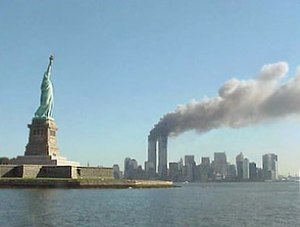 |
| September 11, 2001 attacks in New York City: View of the World Trade Center and the Statue of Liberty. (Image: US National Park Service ) (Photo credit: Wikipedia) |
Castagnera’s Counter-Terrorism Law Course
- Syllabus: Terrorism and Counterterrorism Law in the United States Instructor:James Ottavio Castagnera, JD, PhDAssociate Provost and Associate Counsel for Academic Affairs Rider University, 2083 Lawrenceville Road, Lawrenceville, NJ 08648Emails: castagne@rider.edu castagnerac@aol.comWebsites: http://www.rider.edu/staff/james-castagnera http://jamescastagnera.wordpress.com/Blog: http://terrortrials.blogspot.com/ Course Overview:This online, distance-learning course is intended to introduce you to the American laws relating to terrorism and the combating/prevention of terrorism. My approach to the topic is the case-study method. Each week, we will read a case study, along with the statutes, regulations, and other law-related materials that are relevant to the case. We’ll see how the case was handled in court and what reforms came out of the events that gave rise to the trial.Each week’s assignment will include copies of the relevant laws and court rules; a glossary of terms; background readings, and other supplementary materials.The course commences with the first attempt by Islamic militants to bring down the World Trade Center towers by means of a huge truck bomb in 1993. From there, I take you through the major terrorist incidents of the past 20 years. These include acts perpetrated by homegrown terrorists, such as the Oklahoma City bombing of 1995 and the trial of the SHAC Seven (animal rights) terrorists in Trenton (NJ) in 2006.Course Goals:When you have completed this course, you will:1. Have a broad historical overview of the major terrorist attacks and subsequent legal proceedings in the United States in the 1990s and the first decade of the 21st century;2. Have a broad overview, as well, of the statutes, rules, regulations and legal proceedings related to the detection, prevention and punishment of terrorism in the U.S.;13. Be capable of briefing and analyzing relevant court opinions; and 4. If you are among the better students in the class, be capable of critiquing theAmerican approach to the terrorist challenge, and formulating policy proposals to improve it.Assessment:Your achievements in this course will be assessed as follows:1. Submission of weekly homework assignments posted with and related to the weekly case studies (25%)2. Participation in weekly discussions on line (25%) 3. A final multi-media project, which you will submit online as a PowerPoint filewith video clips, photos, documents and other relevant artifacts embedded and/or attached, as appropriate (50%)All work must be your own. Here are some guidelines to help you avoid plagiarism:1. You MAY NOT simply cut and paste materials from websites. 2. If you quote material, you must provide a citation. 3. If you paraphrase material, you must provide a citation. 4. If you present a photograph, you must provide a photo credit. 5. Any writing not properly cited, per the above rules, is presumed to be youroriginal ideas and words.You are free to use any citation style you are familiar with or comfortable using. But please be consistent. Here are some available choices:MLA: http://owl.english.purdue.edu/owl/resource/747/01/ Bluebook: http://www.legalbluebook.com/ APA: http://www.apastyle.org/ Chicago: http://www.chicagomanualofstyle.org/tools_citationguide.html Noodlebib: http://www.noodletools.com/If you cheat and get caught, you will be given an “F” for the entire course... NO EXCEPTIONS.
Castagnera’s Counter-Terrorism Law Course is available now on Canvas. Check out Canvas at: http://www.instructure.com/students





No comments:
Post a Comment